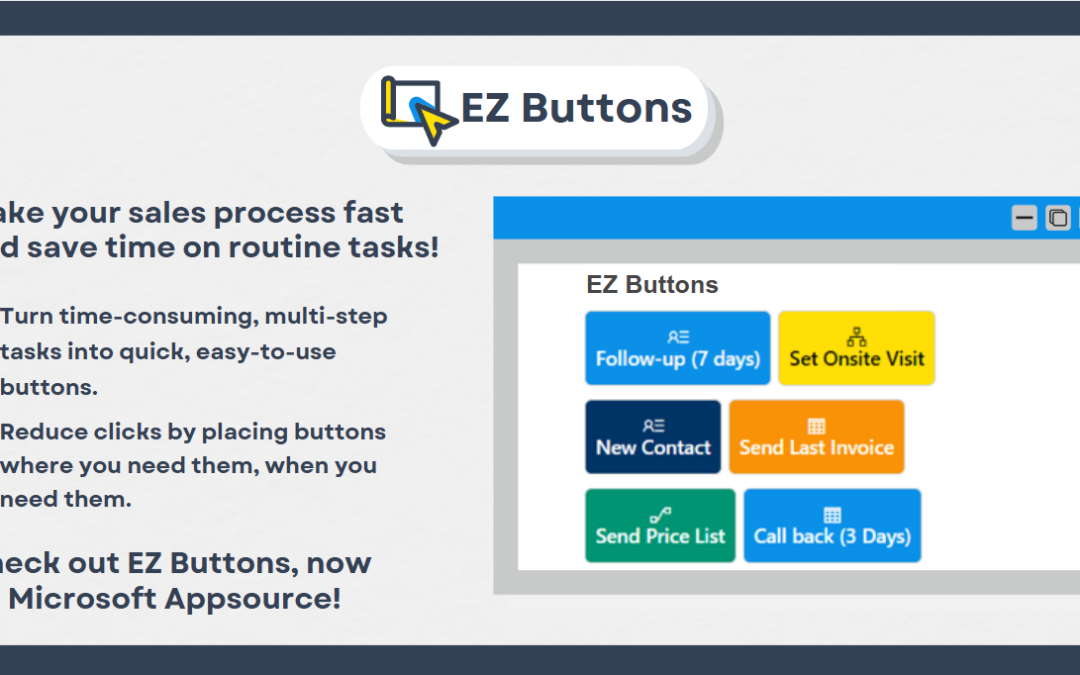Smart IT Services Firms Seize Opportunity with Microsoft Business Applications

As Microsoft moves to the cloud, opportunity abounds
“Accelerating the ISV Opportunity” by Steven “Guggs” Guggenheimer came across my LinkedIn feed recently, and it’s certainly worthy of a read for all of us in the Microsoft Channel—whether you are an Independent Software Vendor (ISV), Office 365 specialist, Managed Services Provider (MSP), traditional Information Technology (IT) Services firm, Dynamics Business Application reseller, or any other type of channel partner.
Most customers and prospective customers would also benefit from reading the article.
The Microsoft transformation
Guggenheimer’s article nicely sums up the current push by Microsoft to help businesses of all shapes and sizes mobilize faster and more effectively to reach their goals through the use of Microsoft technology. The article explains what’s going on with this push, how it’s being driven from the top-most levels within Microsoft, and how Microsoft is helping channel partners and technology-savvy customers succeed with tools and resources.
This massive transformation is unfurling before our eyes, but for most of us, it’s hard to appreciate the magnitude and scope of this transformation and how quickly it’s happening.
A big chunk of the transformation is already well underway with the shift from Microsoft Office on premises to Microsoft Office 365 and the shift from traditional on-premises servers to the Azure Cloud.
Businesses have been moving to Office 365 and Azure Cloud in droves for several years now, and are continuing to do so at an aggressive pace.
The evolution of IT Services
This has created tremendous opportunities for traditional IT service firms to re-align their businesses with the new “technology as a service” model and wrap supporting services up with the Microsoft offerings to provide secure, stable, and dependable access for business users everywhere. This shift gives business leadership the ability to focus more on the way they serve their own customer needs and less on the technology infrastructure.
Technology services are slowly becoming like turning on your water faucet—there when you need them, no questions asked, and with minimal effort.
This shift has been challenging for many traditional IT Service firms.
Some have successfully made the transition and provide phenomenal high-value services with the new model. Others have dismissed the transformation and continue to successfully provide traditional IT services (although in a shrinking set of opportunities). Most firms are somewhere in the middle of these extremes.
And the entire model continues to evolve to balance customer needs with service models that both meet those needs and allow for profitable growth. This non-stop evolution provides an additional set of challenges, as it has become very difficult to adjust to the landscape as the status quo continues to morph.
Going up the ladder
From the Microsoft perspective, the next logical evolutionary step is to shift attention one level up and move Microsoft Business Applications to a connected, cloud model.
We have already seen customers respond enthusiastically to these shifts.
The business community has certainly picked up the pace in adopting cloud business applications over the last few years as more and more customers see the benefits of and feel comfortable with moving to cloud applications.
And Microsoft continues to make this cloud transition attractive by tying the cloud-based Microsoft Business Applications with their easy to understand, easy to tweak, and easy to use set of connected services based around PowerApps, Flow, and Power BI. These services put the power in the hands of the customers to reach their internal goals quickly and cost-effectively, and create a new class of Citizen Developers.
Scary times for IT Services consultants?
From an IT Services provider perspective, there is a potential threat here, because making things easier and more accessible for customers will reduce the need for many of the traditional services that IT firms have provided.
But…that’s ok.
In fact, it’s great.
Once the initial fear of “welp, there goes my business!” quiets down, the smart firms will see the phenomenal opportunities ahead of us all—Microsoft partners and customers alike.
The customer demands
We have to understand and appreciate that this shift to the cloud is not happening on a whim. It’s happening because businesses—the end user customers—are demanding this shift.
These days, businesses need to be more nimble and more responsive, and they need to be able to iterate and pivot cost-effectively. That isn’t as easy to do if they have to reach out to the expert consultant community for every little thing they need.
Not only is there a dollar cost to hiring consulting firm experts, but there is also a sunk time cost to engage and educate the consultants to the point of understanding the core need, waiting for the consultants to provide a proposal to resolve the issue, and then building out and validating the solution.
For business owners, each of those steps represents the loss of precious, unrecoverable time that their competition is using to improve services and sell better.
It’s no longer possible to wait patiently for weeks, months, or even years to deliver modifications or tweaks to business systems.
That’s like waiting for an overnight delivery in an email world. It’s just not practical these days.
The opportunity strikes
The good news is that, much like with the transition from on-premises Office and servers to the cloud, the Microsoft Business Application transition to connected, cloud services represents a transition for related services as well.
Yes, with the rise of the “Citizen Developer” and cloud-based technology, some of the tried-and-true consulting opportunities dry up.
Break/fix work and regular system upgrades are two big categories that will shrivel up and die. And the quick and simple automations will slowly shift from the divine chapels of the experts to the halls of the business person who feels comfortable with macros and drag-and-drop (admittedly, we’re not quite there yet, but…soon).
Good riddance to that work.
Seriously.
As a group, all of us in the IT Services sector should relish leaving behind the simple, less-fulfilling work that customers asked for only begrudgingly.
By shedding those tasks, IT Services providers are free to focus on true value-add services to help our customers reach their goals quickly, effectively, and with creativity.
These services have far more value to the customers and will avoid the price erosion that lower value services face. They will also provide better stickiness for the customer relationship as we become true trusted advisers, aligned to their business goals.
We need to start asking key questions to better understand these services.
How can we help our customers compete better? Sell better? Provide better services? Provide better response time? Establish better cash management techniques? Become leaner, meaner, and more profitable?
Shifting towards those services will greatly increase the overall value a service firm provides to their customers. And this new level of high-value services allow for a world of creativity in methodologies, techniques, tools, and approaches in bringing them to the light of day.
It brings an opportunity for service firms to create real differentiation—to distinguish themselves and become indispensable to their customers.
It’s an exciting new world for both customers and IT Services firms.
The risk before the reward
There is one big catch, though: for many IT Services firms, Microsoft Business Applications are a far cry from their traditional comfort zone in the pure technology arena.
Many IT Services firms have found it difficult enough to shift from on-premises networking services to managed cloud services—and that shift had the benefit of a consistent framework. This was technology IT services firms already understood, targeted primarily at the same buyers within their existing customer base.
Microsoft Dynamics, PowerApps, Flow, and Power BI are a whole new set of animals. Different buyers, different language, different needs, different technologies…the list goes on.
It would be an error to dismiss these differences and only focus on the opportunity.
As much as Microsoft would love all their partners to sell all their lovely products, for many of us in the IT Services space, it can be a daunting prospect to consider investing hundreds of thousands if not millions in building out a new practice area.
And for many of us who have been doing this for a while, we can see the real risk of alienating the first few customers that we take on as we build out a new practice area.
Even still, it’s my opinion that the opportunity is worth the investment, both because of the growing customer demand and the risk of sitting back and ignoring that demand.
Get going—today!
At a bare minimum, smart IT Services leadership should start to sit in on Microsoft sessions about the Microsoft Business Applications—either virtually or at one of the numerous Microsoft events held all over the world throughout the year.
There is some really cool stuff going on, and it demands at least a passing familiarity.
And if you can’t or don’t want to make the investment in building out a Microsoft Business Applications practice internally, find a partner who can help you establish this practice, either short-term to help you launch internally, or long-term as a dependable partner.
My team can help you with both approaches.
We work with dozens of technology-focused IT firms and act as an outsourced practice arm for those firms. We serve their customers with Microsoft Business Applications needs, and help the firms establish a new revenue stream with no financial outlay and no risk.
There are many firms out there who can help you with this, so find one that’s a great fit for you and your team. Look for the firm that fits your style, typical customer profile, vertical focuses, and any other important considerations that you define.
The key thing is that, if you aren’t able to or don’t want to invest in building a new practice area around Business Applications, don’t let that stop you from moving on this opportunity today.
Because—without a doubt—your customers need what Microsoft is building.
If they aren’t getting it from you, they will find another firm that can deliver—and you might find that other firm also provides the IT Services as well.
Azamba Launches EZ Notes: A Smarter, Simpler Way to Take and Manage Notes in Dynamics 365 CRM
Chicago, IL – [March 19th, 2025] - Are messy, disorganized notes wasting your team’s time and leaving critical details lost in the shuffle? Do you spend more time searching for information than acting on it? EZ Notes is here to end the frustration and take the chaos...
Powerful New Updates to Accelerate Sales for Microsoft Dynamics 365 CRM Users
Chicago, IL – [March 5th, 2025] – Azamba is excited to announce the release of EZ Buttons 3.1. This powerful CRM Add-On for Microsoft Dynamics 365 simplifies tasks and makes CRM a breeze to use. With this CRM Add-On, you will work faster and smarter with less...
Azamba releases EZ Buttons 3.0!
Chicago, IL – [November 20th] - We are thrilled to bring you EZ Buttons 3.0, a game-changing update packed with powerful tools to streamline your sales process and help you get more done, faster. With EZ Buttons, turn time-consuming, multi-step tasks into quick,...
Microsoft Dynamics 365 Business Central + CRM Integration Demo | Dynamics Deep Dive Series
In This Demo You Will Learn To: Personalize your CRM to focus on the data that matters most. Create custom dashboards to track critical metrics efficiently. Use data views to help your team make smarter, faster decisions. Simplify Your Sales Process with the Business...
How to Track Your Goals and Metrics in Microsoft Dynamics 365 CRM – Dynamics Deep Dive Series
In the fast-paced world of sales, efficiency and clarity in managing goals and activities are extremely important. Microsoft Dynamics 365 CRM is a transformative solution for sales teams looking to enhance productivity and smash their sales targets. Join experts Peter...
Why MSP’s Should add CRM to their Solution Portfolios
We’re entering a new era in CRM. All the old reasons for customers buying CRM are still valid. But the advent of AI is making the case for renewed interest in CRM. To modify an adage, “If it’s interesting to my customers, then it is fascinating to me!”. AI is...
Boost Your MSP Earnings with Strategic Partnerships
Time is money, we’ve been told since childhood. The idea is that people should focus their attention on the things that bring value to them, and avoid the things that don’t. Since time is a precious resource, it makes sense to try and maximize its utility as it’s the...
CRM Launch in 5 Weeks – Get Results Fast!
CRM is becoming a must-have tool for businesses to stay competitive. But the process of setting it up often wastes time and resources without getting the expected results. To solve this, we've created an approach that makes successful CRM easier to achieve than ever....
How Most CRM Projects Fail & Yours Won’t | CRM Strategy
Did you know that, according to a Gartner study, between 40 to 70% of CRM implementations fail? If you're a small or medium-sized business, this can seriously impact your budget, and you could lose out on profitable opportunities. CRM can be a game-changer for your...
Do This to Avoid Wasting Time and Money With Your CRM
CRM Strategy: The Key to Avoiding a Costly Mistake CRM can either be a game-changing investment for your business or a massive waste of time and money. The difference depends entirely on your approach. Like many businesses, you want to boost sales and increase...
Peter Wolf is the president and founder of Azamba. He has spent the last 18 years focused on helping small and medium-sized businesses become more profitable through effective and efficient usage of CRM.
His passion is blending the promise of CRM with the realities of business needs to create successful outcomes.
Related articles:

Azamba Launches EZ Notes: A Smarter, Simpler Way to Take and Manage Notes in Dynamics 365 CRM
Chicago, IL – [March 19th, 2025] - Are messy, disorganized notes wasting your team’s time and leaving critical details lost in the shuffle? Do you spend more time searching for information than acting on it? EZ Notes is here to end the frustration and take the chaos...

Powerful New Updates to Accelerate Sales for Microsoft Dynamics 365 CRM Users
Chicago, IL – [March 5th, 2025] – Azamba is excited to announce the release of EZ Buttons 3.1. This powerful CRM Add-On for Microsoft Dynamics 365 simplifies tasks and makes CRM a breeze to use. With this CRM Add-On, you will work faster and smarter with less...

Azamba releases EZ Buttons 3.0!
Chicago, IL – [November 20th] - We are thrilled to bring you EZ Buttons 3.0, a game-changing update packed with powerful tools to streamline your sales process and help you get more done, faster. With EZ Buttons, turn time-consuming, multi-step tasks into quick,...

Microsoft Dynamics 365 Business Central + CRM Integration Demo | Dynamics Deep Dive Series
In This Demo You Will Learn To: Personalize your CRM to focus on the data that matters most. Create custom dashboards to track critical metrics efficiently. Use data views to help your team make smarter, faster decisions. Simplify Your Sales Process with the Business...

